Assessment of Equipment and Safety Regulations: A Comparative Study
VerifiedAdded on 2019/10/16
|8
|2027
|404
Report
AI Summary
In this assignment, three case studies were provided: the Bhopal Gas Tragedy, I-35W Mississippi River Bridge collapse, and the Three Mile Island nuclear accident. The common thread among these disasters is the importance of emergency response and preparedness. In the first two cases, there was confusion among employees and staff, leading to slow recognition of the situation's implications. In contrast, the third case saw authorities with preparedness and skills respond effectively. All three cases highlight the need for planned communication efforts and prompt attention to damaged parts. Furthermore, design flaws were identified as contributing factors in two cases, emphasizing the importance of thorough review and approval processes.
Contribute Materials
Your contribution can guide someone’s learning journey. Share your
documents today.
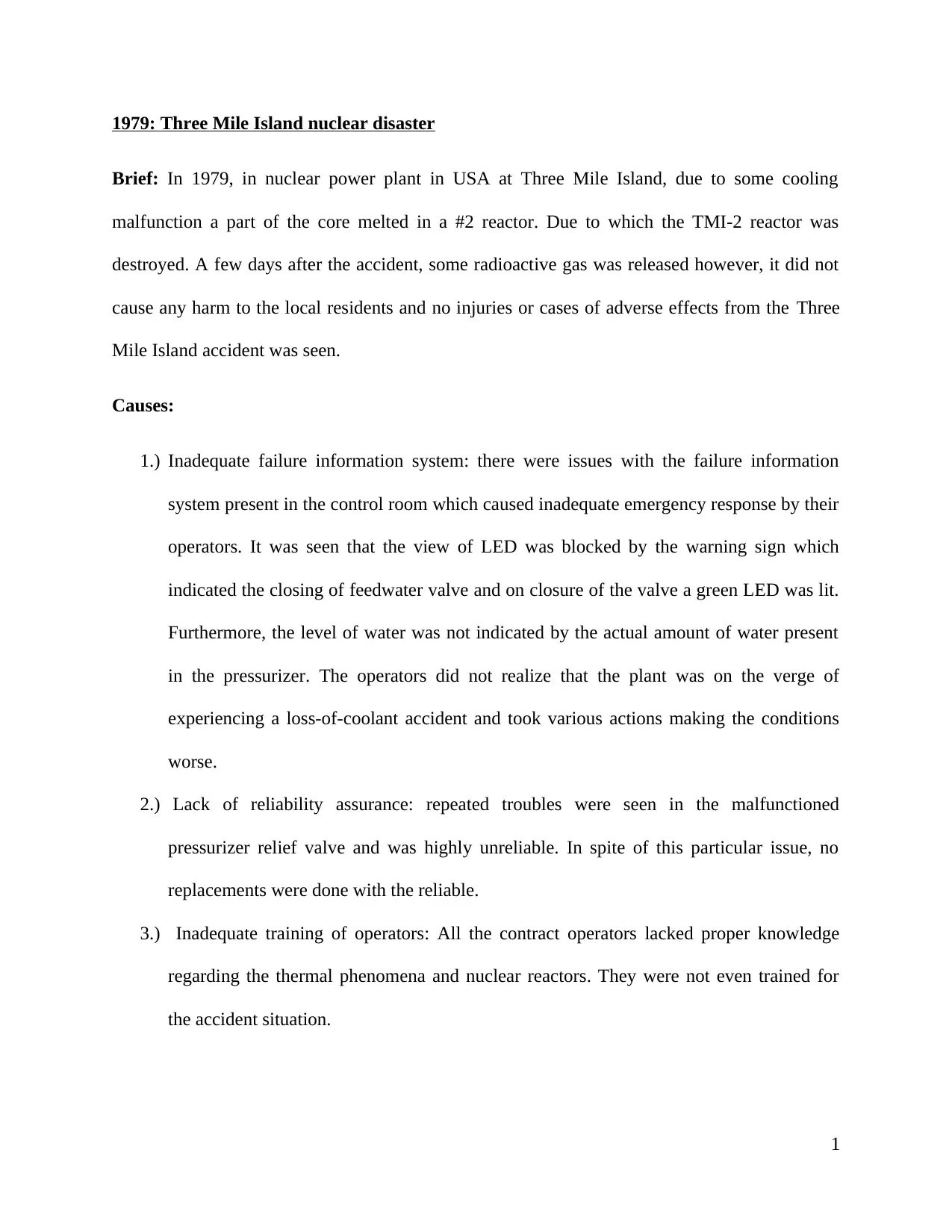
1979: Three Mile Island nuclear disaster
Brief: In 1979, in nuclear power plant in USA at Three Mile Island, due to some cooling
malfunction a part of the core melted in a #2 reactor. Due to which the TMI-2 reactor was
destroyed. A few days after the accident, some radioactive gas was released however, it did not
cause any harm to the local residents and no injuries or cases of adverse effects from the Three
Mile Island accident was seen.
Causes:
1.) Inadequate failure information system: there were issues with the failure information
system present in the control room which caused inadequate emergency response by their
operators. It was seen that the view of LED was blocked by the warning sign which
indicated the closing of feedwater valve and on closure of the valve a green LED was lit.
Furthermore, the level of water was not indicated by the actual amount of water present
in the pressurizer. The operators did not realize that the plant was on the verge of
experiencing a loss-of-coolant accident and took various actions making the conditions
worse.
2.) Lack of reliability assurance: repeated troubles were seen in the malfunctioned
pressurizer relief valve and was highly unreliable. In spite of this particular issue, no
replacements were done with the reliable.
3.) Inadequate training of operators: All the contract operators lacked proper knowledge
regarding the thermal phenomena and nuclear reactors. They were not even trained for
the accident situation.
1
Brief: In 1979, in nuclear power plant in USA at Three Mile Island, due to some cooling
malfunction a part of the core melted in a #2 reactor. Due to which the TMI-2 reactor was
destroyed. A few days after the accident, some radioactive gas was released however, it did not
cause any harm to the local residents and no injuries or cases of adverse effects from the Three
Mile Island accident was seen.
Causes:
1.) Inadequate failure information system: there were issues with the failure information
system present in the control room which caused inadequate emergency response by their
operators. It was seen that the view of LED was blocked by the warning sign which
indicated the closing of feedwater valve and on closure of the valve a green LED was lit.
Furthermore, the level of water was not indicated by the actual amount of water present
in the pressurizer. The operators did not realize that the plant was on the verge of
experiencing a loss-of-coolant accident and took various actions making the conditions
worse.
2.) Lack of reliability assurance: repeated troubles were seen in the malfunctioned
pressurizer relief valve and was highly unreliable. In spite of this particular issue, no
replacements were done with the reliable.
3.) Inadequate training of operators: All the contract operators lacked proper knowledge
regarding the thermal phenomena and nuclear reactors. They were not even trained for
the accident situation.
1
Secure Best Marks with AI Grader
Need help grading? Try our AI Grader for instant feedback on your assignments.
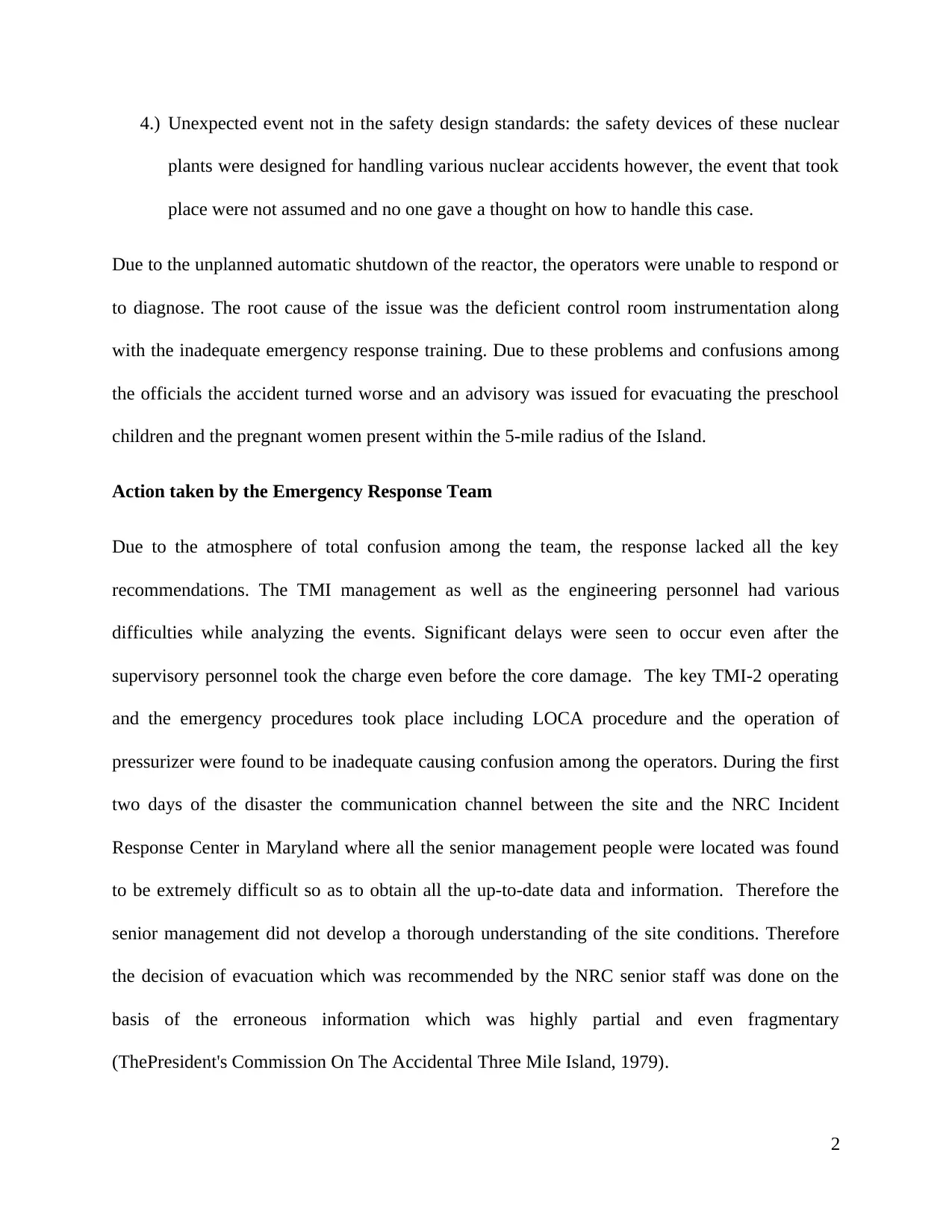
4.) Unexpected event not in the safety design standards: the safety devices of these nuclear
plants were designed for handling various nuclear accidents however, the event that took
place were not assumed and no one gave a thought on how to handle this case.
Due to the unplanned automatic shutdown of the reactor, the operators were unable to respond or
to diagnose. The root cause of the issue was the deficient control room instrumentation along
with the inadequate emergency response training. Due to these problems and confusions among
the officials the accident turned worse and an advisory was issued for evacuating the preschool
children and the pregnant women present within the 5-mile radius of the Island.
Action taken by the Emergency Response Team
Due to the atmosphere of total confusion among the team, the response lacked all the key
recommendations. The TMI management as well as the engineering personnel had various
difficulties while analyzing the events. Significant delays were seen to occur even after the
supervisory personnel took the charge even before the core damage. The key TMI-2 operating
and the emergency procedures took place including LOCA procedure and the operation of
pressurizer were found to be inadequate causing confusion among the operators. During the first
two days of the disaster the communication channel between the site and the NRC Incident
Response Center in Maryland where all the senior management people were located was found
to be extremely difficult so as to obtain all the up-to-date data and information. Therefore the
senior management did not develop a thorough understanding of the site conditions. Therefore
the decision of evacuation which was recommended by the NRC senior staff was done on the
basis of the erroneous information which was highly partial and even fragmentary
(ThePresident's Commission On The Accidental Three Mile Island, 1979).
2
plants were designed for handling various nuclear accidents however, the event that took
place were not assumed and no one gave a thought on how to handle this case.
Due to the unplanned automatic shutdown of the reactor, the operators were unable to respond or
to diagnose. The root cause of the issue was the deficient control room instrumentation along
with the inadequate emergency response training. Due to these problems and confusions among
the officials the accident turned worse and an advisory was issued for evacuating the preschool
children and the pregnant women present within the 5-mile radius of the Island.
Action taken by the Emergency Response Team
Due to the atmosphere of total confusion among the team, the response lacked all the key
recommendations. The TMI management as well as the engineering personnel had various
difficulties while analyzing the events. Significant delays were seen to occur even after the
supervisory personnel took the charge even before the core damage. The key TMI-2 operating
and the emergency procedures took place including LOCA procedure and the operation of
pressurizer were found to be inadequate causing confusion among the operators. During the first
two days of the disaster the communication channel between the site and the NRC Incident
Response Center in Maryland where all the senior management people were located was found
to be extremely difficult so as to obtain all the up-to-date data and information. Therefore the
senior management did not develop a thorough understanding of the site conditions. Therefore
the decision of evacuation which was recommended by the NRC senior staff was done on the
basis of the erroneous information which was highly partial and even fragmentary
(ThePresident's Commission On The Accidental Three Mile Island, 1979).
2

Lessons Learnt:
1.) Responsibility for operation belongs to the management, and not to any federal or state
government or regulators.
2.) The operating crew and its competence is highly vital. The dangerous technologies like
nuclear power and chemical plants.as all these include human in their operation it can
lead to the financial damage along with the societal damage. Therefore care must ne
taken.
1984: Bhopal India Union Carbide incident
Brief: The Bhopal disaster is also known as the Bhopal gas tragedy which is a gas leak incident
in India and is the world’s worst industrial disaster. This incident took place on the night of 2-3
December 1984, at a pesticide plant Union Carbide India Limited (UCIL) in Bhopal, Madhya
Pradesh. Due to the exposure from the methyl isocyanate (MIC) gas and other chemicals. The
shanty towns which were located near the plant were surrounded by the toxic substance (Nair,
n.d.).
Causes:
1.) Underinvestment: The UCIL managers considered high cost cutting leading to the lower
attention being paid towards the maintenance and the safety standards. Due to
underinvestment no maintenance supervisor was placed at the night shifts. Furthermore,
the plant had introduced a careless washing method which started a powerful exothermic
reaction in the plant and its construction in a place with dense population.
2.) Adequacy of equipment and safety regulations:
3
1.) Responsibility for operation belongs to the management, and not to any federal or state
government or regulators.
2.) The operating crew and its competence is highly vital. The dangerous technologies like
nuclear power and chemical plants.as all these include human in their operation it can
lead to the financial damage along with the societal damage. Therefore care must ne
taken.
1984: Bhopal India Union Carbide incident
Brief: The Bhopal disaster is also known as the Bhopal gas tragedy which is a gas leak incident
in India and is the world’s worst industrial disaster. This incident took place on the night of 2-3
December 1984, at a pesticide plant Union Carbide India Limited (UCIL) in Bhopal, Madhya
Pradesh. Due to the exposure from the methyl isocyanate (MIC) gas and other chemicals. The
shanty towns which were located near the plant were surrounded by the toxic substance (Nair,
n.d.).
Causes:
1.) Underinvestment: The UCIL managers considered high cost cutting leading to the lower
attention being paid towards the maintenance and the safety standards. Due to
underinvestment no maintenance supervisor was placed at the night shifts. Furthermore,
the plant had introduced a careless washing method which started a powerful exothermic
reaction in the plant and its construction in a place with dense population.
2.) Adequacy of equipment and safety regulations:
3
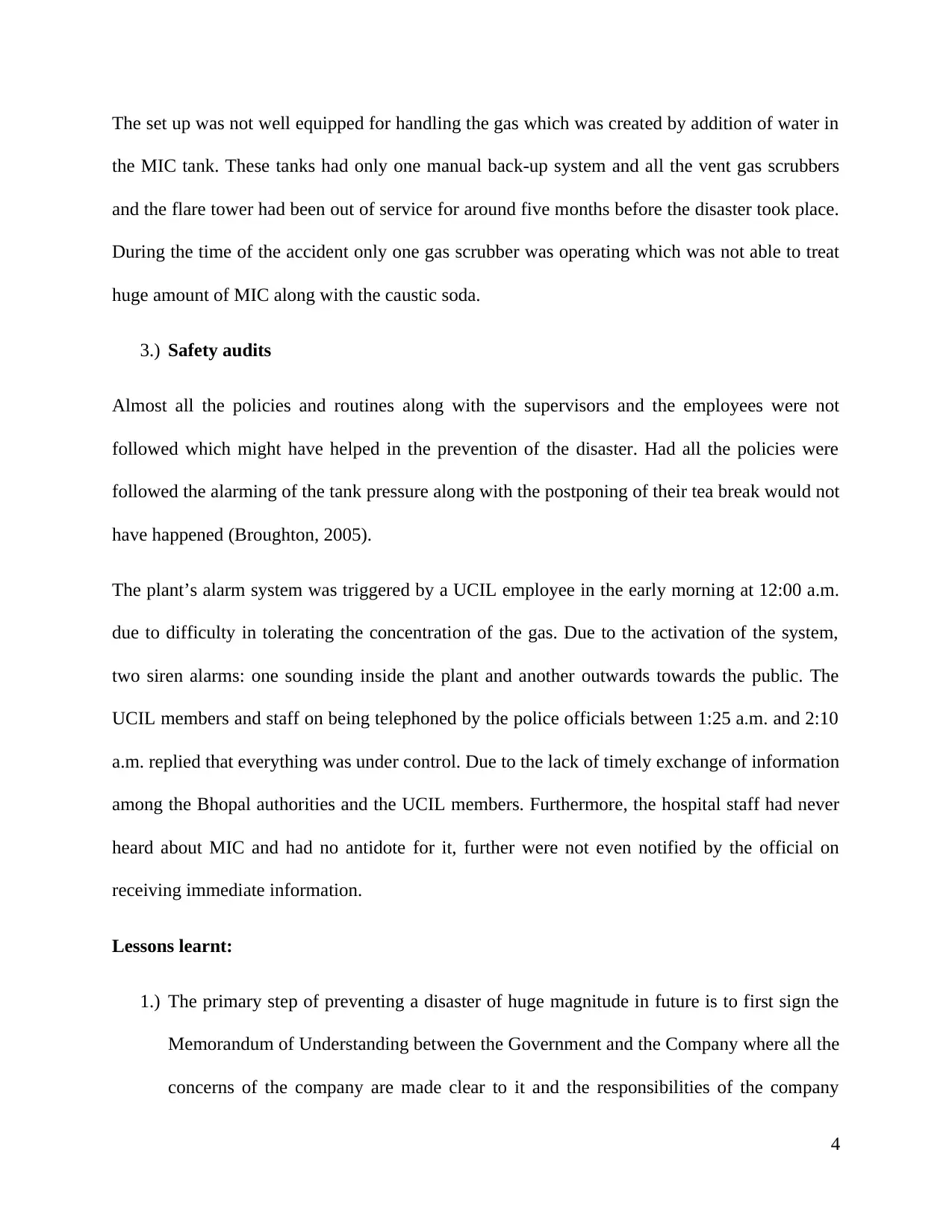
The set up was not well equipped for handling the gas which was created by addition of water in
the MIC tank. These tanks had only one manual back-up system and all the vent gas scrubbers
and the flare tower had been out of service for around five months before the disaster took place.
During the time of the accident only one gas scrubber was operating which was not able to treat
huge amount of MIC along with the caustic soda.
3.) Safety audits
Almost all the policies and routines along with the supervisors and the employees were not
followed which might have helped in the prevention of the disaster. Had all the policies were
followed the alarming of the tank pressure along with the postponing of their tea break would not
have happened (Broughton, 2005).
The plant’s alarm system was triggered by a UCIL employee in the early morning at 12:00 a.m.
due to difficulty in tolerating the concentration of the gas. Due to the activation of the system,
two siren alarms: one sounding inside the plant and another outwards towards the public. The
UCIL members and staff on being telephoned by the police officials between 1:25 a.m. and 2:10
a.m. replied that everything was under control. Due to the lack of timely exchange of information
among the Bhopal authorities and the UCIL members. Furthermore, the hospital staff had never
heard about MIC and had no antidote for it, further were not even notified by the official on
receiving immediate information.
Lessons learnt:
1.) The primary step of preventing a disaster of huge magnitude in future is to first sign the
Memorandum of Understanding between the Government and the Company where all the
concerns of the company are made clear to it and the responsibilities of the company
4
the MIC tank. These tanks had only one manual back-up system and all the vent gas scrubbers
and the flare tower had been out of service for around five months before the disaster took place.
During the time of the accident only one gas scrubber was operating which was not able to treat
huge amount of MIC along with the caustic soda.
3.) Safety audits
Almost all the policies and routines along with the supervisors and the employees were not
followed which might have helped in the prevention of the disaster. Had all the policies were
followed the alarming of the tank pressure along with the postponing of their tea break would not
have happened (Broughton, 2005).
The plant’s alarm system was triggered by a UCIL employee in the early morning at 12:00 a.m.
due to difficulty in tolerating the concentration of the gas. Due to the activation of the system,
two siren alarms: one sounding inside the plant and another outwards towards the public. The
UCIL members and staff on being telephoned by the police officials between 1:25 a.m. and 2:10
a.m. replied that everything was under control. Due to the lack of timely exchange of information
among the Bhopal authorities and the UCIL members. Furthermore, the hospital staff had never
heard about MIC and had no antidote for it, further were not even notified by the official on
receiving immediate information.
Lessons learnt:
1.) The primary step of preventing a disaster of huge magnitude in future is to first sign the
Memorandum of Understanding between the Government and the Company where all the
concerns of the company are made clear to it and the responsibilities of the company
4
Secure Best Marks with AI Grader
Need help grading? Try our AI Grader for instant feedback on your assignments.

must be told in case of any such incident. The company must be asked to pay half of the
compensation to the victims and to the government they signed the memorandum with.
2.) The second step that needs to be taken is that the victim should not be asked to provide
evidence to get his/her compensation. This means that the tort law should not be used
where the victim has to provide evidence for getting compensation.
3.) Various corporate responsibility and accident prevention and other techniques must be
focused on by the international agencies and the national government. These preventions
should include the design, safety legislation and the risk reduction in the location of the
plant (Broughton, 2005).
I-35W Mississippi River Bridge
I-35W Mississippi River Bridge known as Bridge 9340 was a steel truss arch bridge was an
eight-lane bridge which carried the carried Interstate 35W across the Saint Anthony Falls of
the Mississippi River in Minneapolis, Minnesota, United States. On 1st August 2007 the bridge
collapsed suddenly which injured 145 and around 13 succumbed to death. It is the third busiest
bridge of the Minnesota which carried 140,000 vehicles. After this incident a replacement bridge
was planned and the construction started rapidly. The bridge reopened on 18th September 2008
(Zhu, S. et al, 2010).
Cause:
1.) A design flaw was considered to be a factor as cited by NTSB after noting down the too-
thin gusset plate which were ripped along with the rivets lines.
5
compensation to the victims and to the government they signed the memorandum with.
2.) The second step that needs to be taken is that the victim should not be asked to provide
evidence to get his/her compensation. This means that the tort law should not be used
where the victim has to provide evidence for getting compensation.
3.) Various corporate responsibility and accident prevention and other techniques must be
focused on by the international agencies and the national government. These preventions
should include the design, safety legislation and the risk reduction in the location of the
plant (Broughton, 2005).
I-35W Mississippi River Bridge
I-35W Mississippi River Bridge known as Bridge 9340 was a steel truss arch bridge was an
eight-lane bridge which carried the carried Interstate 35W across the Saint Anthony Falls of
the Mississippi River in Minneapolis, Minnesota, United States. On 1st August 2007 the bridge
collapsed suddenly which injured 145 and around 13 succumbed to death. It is the third busiest
bridge of the Minnesota which carried 140,000 vehicles. After this incident a replacement bridge
was planned and the construction started rapidly. The bridge reopened on 18th September 2008
(Zhu, S. et al, 2010).
Cause:
1.) A design flaw was considered to be a factor as cited by NTSB after noting down the too-
thin gusset plate which were ripped along with the rivets lines.
5
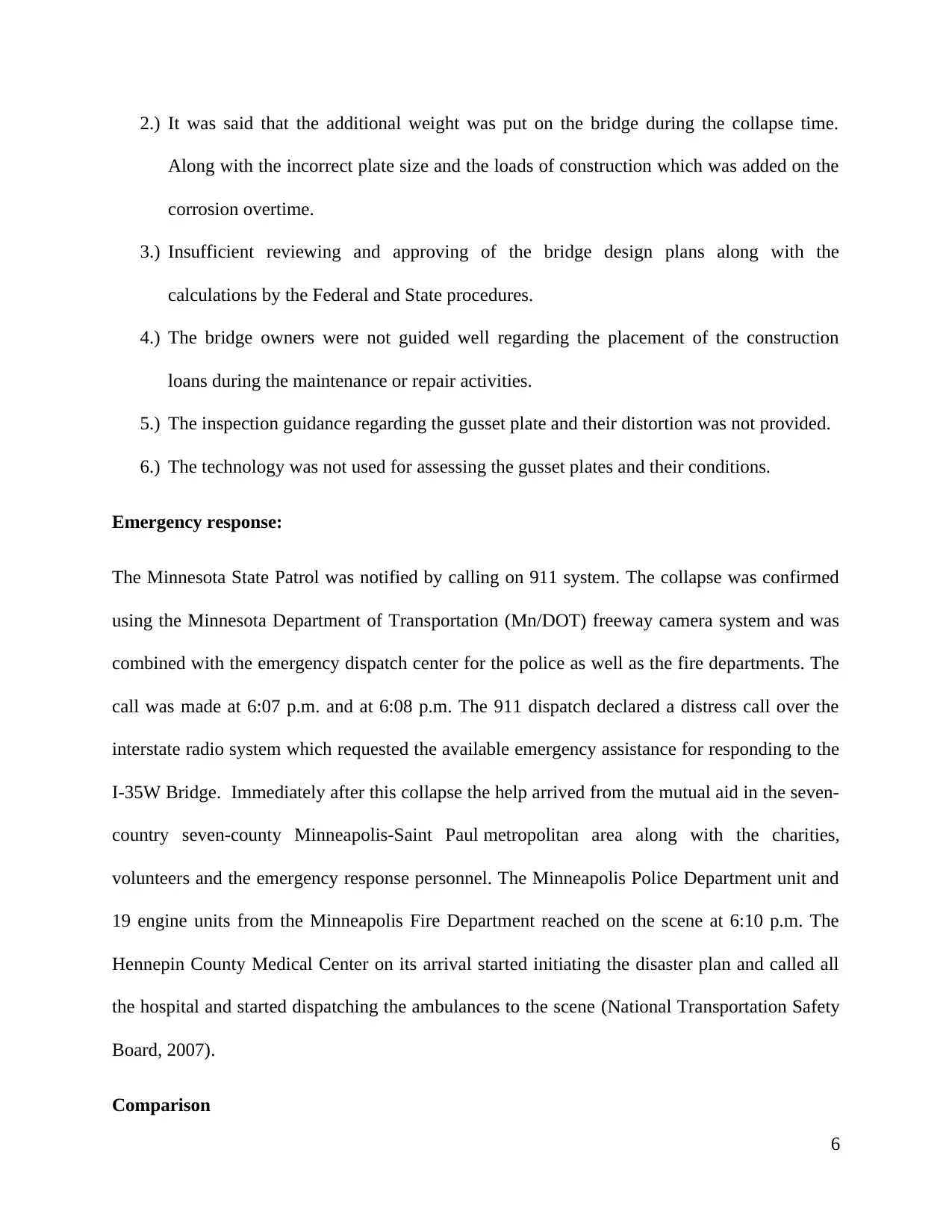
2.) It was said that the additional weight was put on the bridge during the collapse time.
Along with the incorrect plate size and the loads of construction which was added on the
corrosion overtime.
3.) Insufficient reviewing and approving of the bridge design plans along with the
calculations by the Federal and State procedures.
4.) The bridge owners were not guided well regarding the placement of the construction
loans during the maintenance or repair activities.
5.) The inspection guidance regarding the gusset plate and their distortion was not provided.
6.) The technology was not used for assessing the gusset plates and their conditions.
Emergency response:
The Minnesota State Patrol was notified by calling on 911 system. The collapse was confirmed
using the Minnesota Department of Transportation (Mn/DOT) freeway camera system and was
combined with the emergency dispatch center for the police as well as the fire departments. The
call was made at 6:07 p.m. and at 6:08 p.m. The 911 dispatch declared a distress call over the
interstate radio system which requested the available emergency assistance for responding to the
I-35W Bridge. Immediately after this collapse the help arrived from the mutual aid in the seven-
country seven-county Minneapolis-Saint Paul metropolitan area along with the charities,
volunteers and the emergency response personnel. The Minneapolis Police Department unit and
19 engine units from the Minneapolis Fire Department reached on the scene at 6:10 p.m. The
Hennepin County Medical Center on its arrival started initiating the disaster plan and called all
the hospital and started dispatching the ambulances to the scene (National Transportation Safety
Board, 2007).
Comparison
6
Along with the incorrect plate size and the loads of construction which was added on the
corrosion overtime.
3.) Insufficient reviewing and approving of the bridge design plans along with the
calculations by the Federal and State procedures.
4.) The bridge owners were not guided well regarding the placement of the construction
loans during the maintenance or repair activities.
5.) The inspection guidance regarding the gusset plate and their distortion was not provided.
6.) The technology was not used for assessing the gusset plates and their conditions.
Emergency response:
The Minnesota State Patrol was notified by calling on 911 system. The collapse was confirmed
using the Minnesota Department of Transportation (Mn/DOT) freeway camera system and was
combined with the emergency dispatch center for the police as well as the fire departments. The
call was made at 6:07 p.m. and at 6:08 p.m. The 911 dispatch declared a distress call over the
interstate radio system which requested the available emergency assistance for responding to the
I-35W Bridge. Immediately after this collapse the help arrived from the mutual aid in the seven-
country seven-county Minneapolis-Saint Paul metropolitan area along with the charities,
volunteers and the emergency response personnel. The Minneapolis Police Department unit and
19 engine units from the Minneapolis Fire Department reached on the scene at 6:10 p.m. The
Hennepin County Medical Center on its arrival started initiating the disaster plan and called all
the hospital and started dispatching the ambulances to the scene (National Transportation Safety
Board, 2007).
Comparison
6
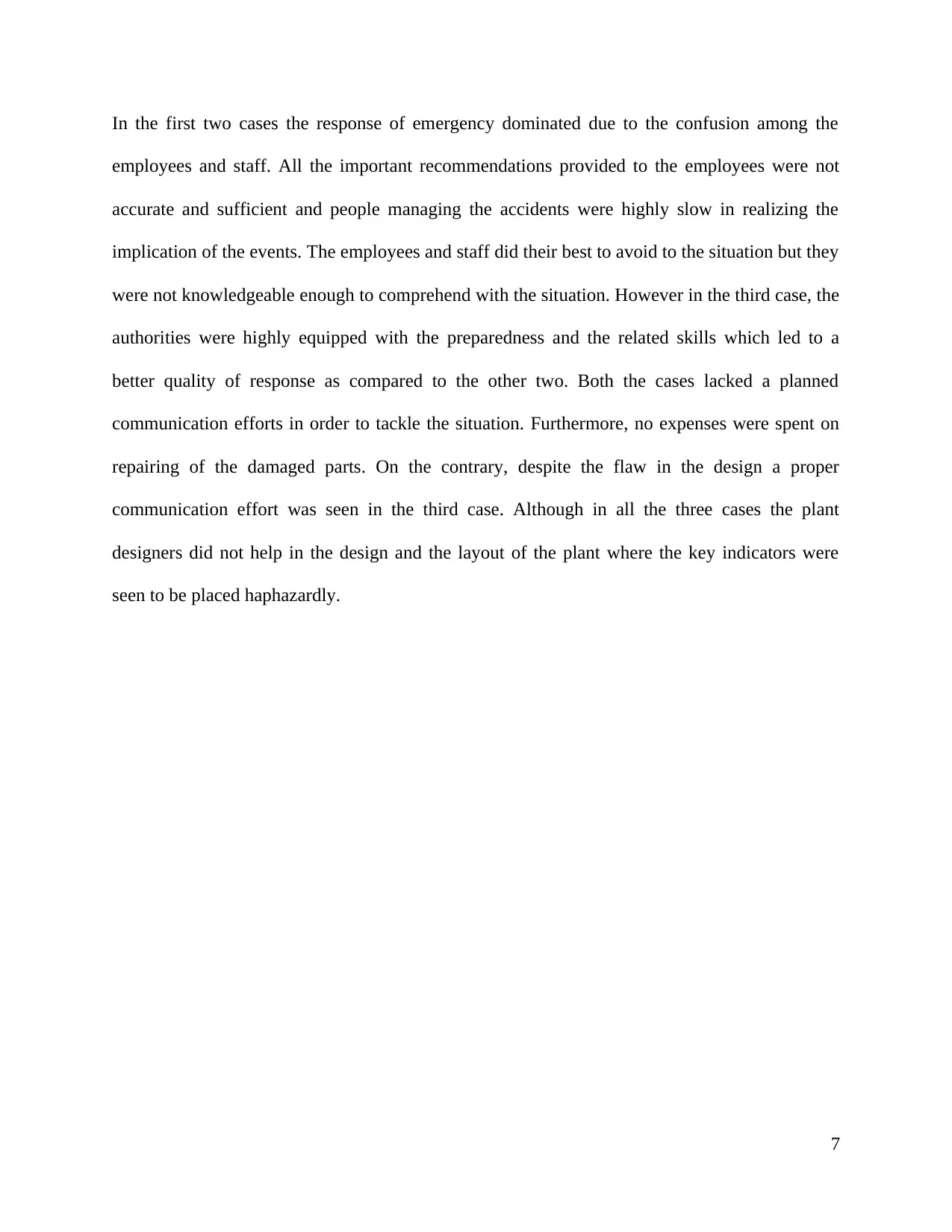
In the first two cases the response of emergency dominated due to the confusion among the
employees and staff. All the important recommendations provided to the employees were not
accurate and sufficient and people managing the accidents were highly slow in realizing the
implication of the events. The employees and staff did their best to avoid to the situation but they
were not knowledgeable enough to comprehend with the situation. However in the third case, the
authorities were highly equipped with the preparedness and the related skills which led to a
better quality of response as compared to the other two. Both the cases lacked a planned
communication efforts in order to tackle the situation. Furthermore, no expenses were spent on
repairing of the damaged parts. On the contrary, despite the flaw in the design a proper
communication effort was seen in the third case. Although in all the three cases the plant
designers did not help in the design and the layout of the plant where the key indicators were
seen to be placed haphazardly.
7
employees and staff. All the important recommendations provided to the employees were not
accurate and sufficient and people managing the accidents were highly slow in realizing the
implication of the events. The employees and staff did their best to avoid to the situation but they
were not knowledgeable enough to comprehend with the situation. However in the third case, the
authorities were highly equipped with the preparedness and the related skills which led to a
better quality of response as compared to the other two. Both the cases lacked a planned
communication efforts in order to tackle the situation. Furthermore, no expenses were spent on
repairing of the damaged parts. On the contrary, despite the flaw in the design a proper
communication effort was seen in the third case. Although in all the three cases the plant
designers did not help in the design and the layout of the plant where the key indicators were
seen to be placed haphazardly.
7
Paraphrase This Document
Need a fresh take? Get an instant paraphrase of this document with our AI Paraphraser
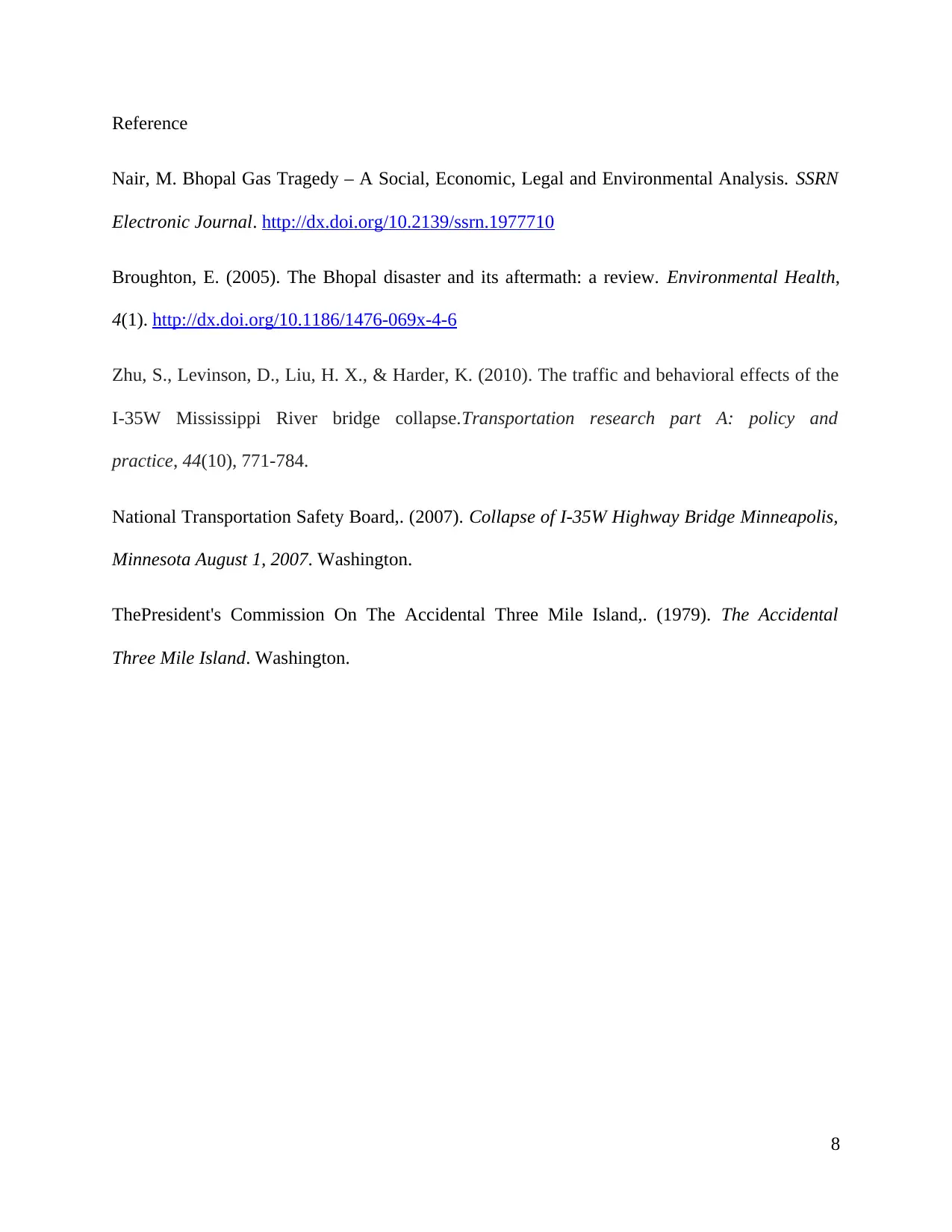
Reference
Nair, M. Bhopal Gas Tragedy – A Social, Economic, Legal and Environmental Analysis. SSRN
Electronic Journal. http://dx.doi.org/10.2139/ssrn.1977710
Broughton, E. (2005). The Bhopal disaster and its aftermath: a review. Environmental Health,
4(1). http://dx.doi.org/10.1186/1476-069x-4-6
Zhu, S., Levinson, D., Liu, H. X., & Harder, K. (2010). The traffic and behavioral effects of the
I-35W Mississippi River bridge collapse.Transportation research part A: policy and
practice, 44(10), 771-784.
National Transportation Safety Board,. (2007). Collapse of I-35W Highway Bridge Minneapolis,
Minnesota August 1, 2007. Washington.
ThePresident's Commission On The Accidental Three Mile Island,. (1979). The Accidental
Three Mile Island. Washington.
8
Nair, M. Bhopal Gas Tragedy – A Social, Economic, Legal and Environmental Analysis. SSRN
Electronic Journal. http://dx.doi.org/10.2139/ssrn.1977710
Broughton, E. (2005). The Bhopal disaster and its aftermath: a review. Environmental Health,
4(1). http://dx.doi.org/10.1186/1476-069x-4-6
Zhu, S., Levinson, D., Liu, H. X., & Harder, K. (2010). The traffic and behavioral effects of the
I-35W Mississippi River bridge collapse.Transportation research part A: policy and
practice, 44(10), 771-784.
National Transportation Safety Board,. (2007). Collapse of I-35W Highway Bridge Minneapolis,
Minnesota August 1, 2007. Washington.
ThePresident's Commission On The Accidental Three Mile Island,. (1979). The Accidental
Three Mile Island. Washington.
8
1 out of 8
Your All-in-One AI-Powered Toolkit for Academic Success.
+13062052269
info@desklib.com
Available 24*7 on WhatsApp / Email
![[object Object]](/_next/static/media/star-bottom.7253800d.svg)
Unlock your academic potential
© 2024 | Zucol Services PVT LTD | All rights reserved.
